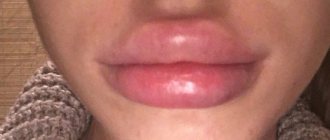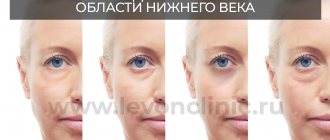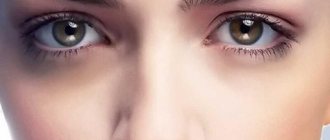The scattering of light by particles in a colloid or a fine suspension
Flour suspended in water appears blue because only diffuse light reaches the viewer, and blue light is scattered more by flour particles than red light.
Tyndall effect
is the scattering of light by particles in a colloid or very fine suspension.
Also known as Tyndall scattering
, it is similar to Rayleigh scattering, in which the intensity of the scattered light is inversely proportional to the fourth power of the wavelength, so blue light is scattered much more strongly than red light. An example in everyday life is the blue color sometimes seen in the smoke coming from motorcycles, particularly two-stroke cars, where burnt motor oil contains these particles.
Under Tyndall's action, longer wavelengths are more transmitted while shorter wavelengths are more diffusely reflected through scattering. The Tyndall effect is seen when light-scattering solid particles disperse an otherwise light-transmitting medium, when the diameter of an individual particle is in the range of approximately 40 to 900, that is, somewhat below or near the wavelength of visible light (400–750 nm).
This is particularly applicable to colloidal mixtures and thin suspensions; for example, the Tyndall effect is used in nephelometers to determine the size and density of particles in aerosols and other colloidal substances (see ultramicroscope and turbidimeter).
It is named after the 19th century physicist John Tyndall, who was the first to study the phenomenon extensively.
Opening[edit]
Before the discovery of this phenomenon, John Tyndall was primarily known for his work on the absorption and emission of radiant heat at the molecular level. In his research in this field it became necessary to use air from which all traces of floating dust and other particulate matter had been removed, and the best way to detect these particles was to bathe the air in intense light. [1] In the 1860s, John Tyndall conducted a series of experiments with light passing through various gases and liquids and recorded the results. At the same time, Tyndall discovered that when the tube was gradually filled with smoke and then passed through it, a beam of light appeared blue from the sides of the tube, but red from the far end. [2] This observation allowed Tyndall to first propose the phenomenon that would later bear his name.
Features of correction with hyaluronidase
The Tyndall effect can be corrected in various ways, but the most popular method in cosmetology is the introduction of hyaluronidase. In this case, it does not matter at what interval the second drug is administered. Even if hyaluronidase is used several years after an overdose of hyaluronic acid, all signs of the Tyndall effect will disappear within about 3 days.
In aesthetic medicine, there are cases where the enzyme helped get rid of complications that appeared more than 5 years ago. Much depends on the type of fluid injected. Some types of hyaluronic acid are less sensitive to hyaluronidase and may take longer to resolve symptoms.
During correction, a mandatory condition for all patients is to undergo a procedure to check the reaction to the introduction of the enzyme.
The specialist must conduct an intradermal test. This liquid must be mixed with saline before microinjection. Cosmetologists have been using hyaluronidase for many years because it is harmless and helps get rid of side effects in a very short time. This drug also helps reduce the risk of skin necrosis.
After administering the enzyme, the doctor should observe the patient for about an hour to exclude possible complications after treatment. After correction, it is possible to re-introduce hyaluronic acid no earlier than after 15 days. But if the cosmetologist again administers the drug incorrectly, the complications may be even more severe, and re-treatment will take a longer time.
Comparison with Rayleigh scattering[edit]
Tyndall effect in opalescent glass: from the side it appears blue, but orange light shines through it.
[3] Rayleigh scattering is defined by a mathematical formula that requires the light-scattering particles to be much smaller than the wavelength of light. [4] For particle dispersion to comply with Rayleigh's formula, particle sizes must be below about 40 nanometers (for visible light) [ citation needed
], and the particles can be individual molecules.
[4] Colloidal particles are larger and roughly the same size as the wavelength of light. Tyndall scattering, which is the scattering of colloidal particles, [5] is much more intense than Rayleigh scattering due to the larger particles involved [ citation needed
]. The importance of the particle size factor to intensity can be seen in the large exponent it has in the mathematical formulation of Rayleigh scattering intensity. If colloidal particles are spheroidal, then Tyndall scattering can be analyzed mathematically in terms of Mie theory, which allows particle sizes in the rough neighborhood of the wavelength of light. [4] Light scattering by particles of complex shape is described by the T-matrix method. [6]
In the area of nasolabial folds
Many girls after 30 years begin to be bothered by pronounced nasolabial folds. In addition to age, this is influenced by the quality of skin care, lifestyle and heredity. Recently, more and more women are turning to a cosmetologist to improve the appearance of their nasolabial folds. Most often, adjustments are made using hyaluronic acid.
It fills wrinkles, and the result is visible after just 1 procedure. But after 6-9 months the injection must be repeated to maintain the effect. The procedure is performed under local anesthesia because the area is very sensitive. Improper administration of the drug can cause various side effects, for example, the Tyndall effect.
Typically, dark blue or gray hematomas appear in the upper third of the nasolabial folds, because this area has an intense blood supply.
The capillaries are very close to the surface of the skin, and there is very little subcutaneous fat. If herpetic infections periodically occur on the skin, doctors recommend taking a course of antiviral drugs in advance.
Also, after the introduction of fillers, it is recommended to extend the course for about 2 weeks. Cosmetologists advise using sunscreen to increase the effect of hyaluronic acid and also eliminate the risk of side effects.
Blue irises[edit]
Blue iris
The blue iris of the eye is due to Tyndall scattering in the translucent layer of the iris. Brown and black irises have the same layer, but it contains more melanin. Melanin absorbs light. In the absence of melanin, the layer is translucent (i.e., light passing through it is scattered randomly and diffusely), and a significant portion of the light that enters this translucent layer exits again through the scattered path. That is, there is backscattering, the redirection of light waves back to the open air. Scattering occurs to a greater extent at shorter wavelengths. The longer wavelengths tend to pass straight through the translucent layer in unchanging paths and then meet the next layer further in the iris, which is a light absorber. Thus, longer waves are not reflected (scattered) back into the open air as much as shorter waves. Since shorter wavelengths are blue wavelengths, this results in a blue tint to the light coming from the eye. [7] [8] The blue iris is an example of a structural color as opposed to a pigment color.
Precautionary measures
Unfortunately, the formation of swelling and bruising is a common occurrence in cosmetology. But you can reduce the risk of their occurrence by choosing an experienced specialist. A professional always collects a detailed medical history of the patient before introducing filler and “tests” the correction area with small volumes of the drug: 0.2-0.5 ml.
After the procedure, the patient must follow all recommendations for caring for the injured area. Otherwise, even after a high-quality filler injection, there is a risk of complications and, as a result, unforeseen results.
Similar phenomena not related to Tyndall scattering[edit]
When the daytime sky is overcast, sunlight passes through the cloudy layer of clouds, resulting in diffuse light on the ground. This demonstrates Mie scattering instead of Tyndall scattering because cloud droplets are larger than the wavelength of light and scatter all colors approximately equally. [9] When the daytime sky is cloudless, the color of the sky is blue due to Rayleigh scattering rather than Tyndall scattering because the scattering particles are air molecules that are much smaller than the wavelength of visible light. [10] Similarly, the term Tyndall effect
incorrectly applied to the scattering of light by large macroscopic dust particles in the air; however, due to their large size, they do not exhibit Tyndall scattering. [eleven]
Tyndall effect
The Tyndall effect was discovered as a result of a scientist's study of the interaction of light rays with various media. He found that when light rays pass through a medium containing a suspension of tiny solid particles - for example, dusty or smoky air, colloidal solutions, cloudy glass - the scattering effect decreases as the spectral color of the beam changes from violet-blue to yellow-red part of the spectrum. If, however, white light, such as sunlight, which contains the full color spectrum, is passed through a turbid medium, then the light in the blue part of the spectrum will be partially scattered, while the intensity of the green-yellow-red part of the light will remain almost the same. Therefore, if we look at scattered light after it has passed through a cloudy medium away from the light source, it will appear bluer than the original light. If we look at a light source along the scattering line, that is, through a turbid medium, the source will seem redder to us than it actually is. This is why haze from forest fires, for example, appears bluish-violet to us.
The Tyndall effect occurs when scattered by suspended particles whose dimensions exceed the dimensions of atoms by tens of times. When suspension particles enlarge to sizes of the order of 1/20 of the light wavelength (from approximately 25 nm and above), the scattering becomes polychromatic,
that is, the light begins to scatter evenly over the entire visible range of colors from violet to red. As a result, the Tyndall effect disappears. This is why dense fog or cumulus clouds appear white to us - they consist of a dense suspension of water dust with particle diameters ranging from microns to millimeters, which is well above the Tyndall scattering threshold.
You might think that the sky appears blue to us due to the Tyndall effect, but this is not so. In the absence of clouds or smoke, the sky turns blue due to the scattering of “daylight” by air molecules. This type of scattering is called Rayleigh scattering
(after Sir Rayleigh;
see
Rayleigh criterion). In Rayleigh scattering, blue and blue light is scattered even more than in the Tyndall effect: for example, blue light with a wavelength of 400 nm is scattered in clean air nine times more strongly than red light with a wavelength of 700 nm. This is why the sky appears blue to us - sunlight is scattered across the entire spectral range, but in the blue part of the spectrum it is almost an order of magnitude stronger than in the red. Ultraviolet rays that cause sun tanning are scattered even more strongly. That is why the tan is distributed fairly evenly over the body, covering even those areas of the skin that are not exposed to direct sunlight.
Consequences of filler injections
The consequences of injections from fillers can be early and delayed, mild/moderate and severe. The most complex and dangerous consequence is tissue necrosis, which is caused by damage to a blood vessel at the time of injection and penetration of the drug directly into it.
This complication can only be treated surgically and requires a long rehabilitation period; often patients are subsequently forced to seek help from plastic surgeons.
After a filler injection, you can expect the formation of a small bruise and the appearance of extensive swelling, but, according to statistics, such manipulations take place without any serious consequences.
Got into a vessel during lip augmentation
If the doctor gets into a vessel during filler injection, then large swelling and loose local swelling will appear against the background of lip augmentation. The best solution to the problem is to inject the enzyme longidase or hyaluroidase under the skin, which will dissolve the filler and remove the drug from the body. As a rule, already on the 3rd day all changes in the lip area due to vessel injury disappear.
Such therapy can lead to the formation of a salivary gland cyst or its false analogue. Treatment of such a formation comes down to rinsing the mouth with decoctions of calendula or chamomile flowers, applying an iodine network at the site of the formation. For an accurate diagnosis, an ultrasound examination is necessary.
Consequences of fillers after a few years
In medicine, there is the concept of “delayed complications” - this is when the consequences of fillers appear several years after the manipulation. These include:
- filler migration under the skin;
- inflammatory processes of a granulomatous nature;
- formation of scars, bumps, scars.
Filler migration
Such delayed complications can only be treated surgically, after which the patient will need to undergo a fairly long recovery period.
The filler does not dissolve
If a filler based on hyaluronic acid was injected, and it does not resolve after a few months/year, then you should seek help from cosmetologists. Even after a year, small lumps may remain at the filler injection site, which will need to be removed using one of the available methods:
- active massage to “dissolve” the filler – it rarely helps, it all depends on the individual characteristics of the body;
- introduction of a specific enzyme for resorption of hyaluronic acid;
- surgical removal of filler remnants.
If the filler has not dissolved even 12-18 months after injection, but the injection site retains its original shape, then there is nothing to worry about - the effect of the injections simply lasts longer, which is an individual feature.
Watch this video about how excess filler is removed using hyaluronidase:
Allergy to fillers
Allergy to fillers is the most common complication that occurs after anti-aging/corrective procedures. It can occur immediately during the procedure or after a few days - it all depends on the level of the patient’s immune system. It is usually manifested by swelling, redness, and changes in skin texture.
In severe cases, bronchial spasms, increased body temperature and swelling of the larynx may be present, up to anaphylactic shock. The latter condition always develops acutely, rapidly and immediately after the drug enters the body.
Allergy to fillers
If the allergy is mild, then to restore your health, it is enough to take antihistamines such as Zodak, Suprastin, Tavegil and others for 3-5 days. In case of severe allergic reactions, the doctor must quickly eliminate the irritant - dissolve and remove the filler from the body. This is done by introducing hyaluronidase.
Filler migration
Migration of hyaluronic acid-based filler is extremely rare, but if a silicone-based preparation was used in the manipulation, then such a complication occurs in 80% of cases. Moreover, silicone fillers are capable of migrating to very distant areas of the face (from the injection sites).
Most often, migration of hyaluronic filler occurs during lip correction - “popcorn lip” syndrome occurs, which can only be eliminated surgically or by introducing a resorbable substance.
After 10 years, the woman experienced migration of silicone filler
This side effect is delayed in nature, so when the first signs of filler movement under the skin appear, you need to contact a cosmetologist for help - you will be able to maintain a pleasant appearance and, in most cases, avoid full-fledged surgical treatment.
Tandal effect stones
The Tyndall cone is observed in refined stones that have the ability to exhibit opalescence:
- Opal;
- Amethyst;
- Quartz;
- Amber.
from left to right amber, quartz, amethyst
It should be noted that depending on the geometric features of the surface of the particles, they reflect the rays differently. If their thickness is less than or equal to the wavelength of white light, the observer will be able to see a rainbow glow. Solid blue, appears when illuminated by bute opal.
opal butte











